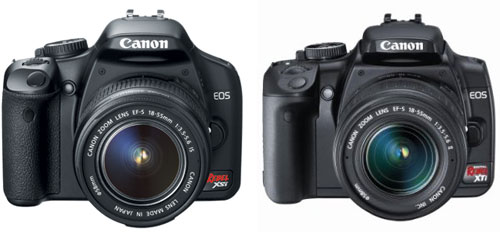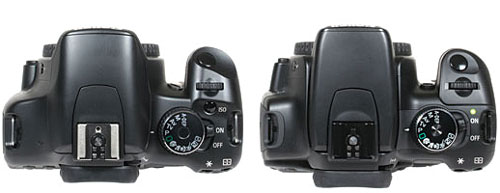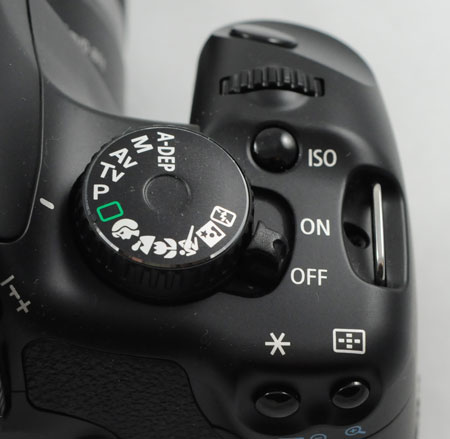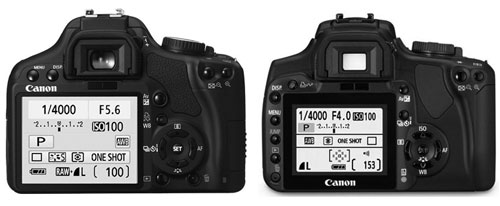Canon XSi: 12.2 Megapixels, Image Stabilized Lens, and Double Live View
by Wesley Fink on May 5, 2008 3:00 AM EST- Posted in
- Digital Camera
XSi compared to XTi
As the top-selling model in the DSLR universe, each new Canon builds on the previous model's footprint and features. This evolutionary approach keeps new Rebels familiar, but Canon also has managed to keep their entry flagship fresh with the latest must-have features and new Canon innovations.

The XSi is more rounded and less angular than the XTi. It is also slightly larger than the XTi to accommodate the larger 3" LCD.
| Canon XSi vs. Canon XTi | ||
| XSi | XTi | |
| Dimensions | 129 x 97.5 x 61.9mm 5.1 x 3.8 x 2.4" |
126.5 x 94.2 x 65mm 5.0 x 3.7 x 2.6" |
| Weight | 475g (16.8oz) - Body only 525g (18.5oz) - with Battery |
510g (18oz) - Body Only 556g (19.6oz) |
The XSi is 2.5mm wider and 3.3mm taller than the XTi. However, it is 3.1mm less deep and 35g lighter than the current XTi. The overall impression is the XSi is slightly larger than the XTi, and it is surprisingly light. The rubber grip cover is now more "texturized" with subtle changes to the shutter release depression and angle. The grip is more comfortable to hold for larger hands (still improved by adding the grip), but it is a good fit for smaller hands.
Build quality seems a cut above earlier Rebels and the appearance is definitely classier and more in keeping with the rest of the Canon DSLR line. The XSi has been described as looking like a mini 40D and that is an apt description. The XSi is also the most rugged Digital Rebel ever built with a stainless-steel chassis and a glass-reinforced engineering plastics body.

The XTi ON LED is gone, something that may matter to some users. If you look closely you can see that the shallower XSi is entirely due to the stubbier pentamirror/flash housing, which does not overhang as much as in the XTi.

The XSi adds an ISO button just above the on-off switch. ISO is also now displayed in the viewfinder (finally!).

The biggest changes in the XSi are on the back where the new 3" LCD looks absolutely massive compared to the XTi's 2.5" screen. The 3" screen is the same size and specifications as the Canon 40D screen. It is also the largest screen in its class - the Nikon D60 and Olympus 510/420 are 2.5", while the Sony A350/300/200 and Pentax K200D are 2.7".
The larger screen on the XSi required a complete rearrangement of rear buttons as well. There are no longer buttons on the left and the Menu and Display buttons are now at the top left of the screen.
The right side control buttons and layout are basically the same as the XTi, with the addition of the playback and delete (trash) buttons at the bottom right of the screen. The drive/timer button has been reassigned to a directional pad button and the old button is now assigned to White Balance. In a quick glance at the XSi rear you would think it has been simplified, as it looks as if there are fewer buttons. However, all the buttons and functions are still there; they are just rearranged.

The XSi is the first Canon camera to use SD cards, a break with all previous Digital Rebels that used Compact Flash cards. This is really not a handicap at all since SD cards are now priced about the same as Compact Flash. The latest Class 6 SDHC cards are also very fast, just like the high-speed CF cards. All test shots with the XSi used a 16GB Class 6 SDHC card for image storage. The operation was trouble free and very fast.

XSi introduces a new battery that is incompatible with past models. The electrical contacts are contained in the bump on the battery - presumably to prevent accidental contact and discharge in the camera bag. The new LP-E5 (50g) rechargeable battery weighs about the same as the NB-2LH (46g) which powered the XT and XTi models. However, battery output increases about 50% to 1080 mAh compared to the 720 mAh of the NB-2LH. Battery life was not an issue with the XTi as Canon CMOS sensors are justly famous for low power consumption. The XSi battery life is even better, with plenty of reserve for driving the 3" LCD and Live View.

With the new LP-E5 battery also comes a new battery grip called the BP-E5. Then new BP-E5 works only on the XSi; it is incompatible with the earlier Digital Rebel grip. The earlier BP-E3 will not work on the XSi.
The new BP-E5 requires the battery cover be removed for mounting. The grip has a place to store the battery cover on the grip so it is not lost. Power for the grip is either one or two LP-E5 batteries. The grip also comes with an AA battery holder for six AA-size batteries as an alternate power source. We tested the grip with high-capacity rechargeable AA batteries and they worked fine as a power source.
It is definitely worth mentioning that the grip with two BP-E5 batteries is still extremely light, but the two dedicated batteries pack a wallop with 2160 mAh available. Unlike the Sony proprietary batteries, the new LP-E5 batteries are already available OEM from third party vendors.
An added feature of the BP-E5 is that it does provide some weather sealing, unlike the previous Digital Rebel grip. While Canon does not make a big deal of the feature, the XSi does provide some weather sealing, which is more a prosumer model feature.










56 Comments
View All Comments
meanjean - Wednesday, September 3, 2008 - link
Anyone had trouble with memory cards not recording pictures because of being dislodged from contact points for some reason?thepieces - Saturday, May 10, 2008 - link
Cool review, but the samples are horrible. A little more effort than images from your back yard please :) Half of which are out of focusMidwayman - Friday, May 9, 2008 - link
"Early testing shows the new 18-55mm IS to be a superb lens with performance comparable to top-line Canon lenses."So you're saying the kit lens is up to L quality. Right.
Also that Nvidia test target you are using is really a pretty poor choice. Almost no fine detail. Noise is only have the story when comparing high iso. You also need to look at detail retention. The only thing that could possibly qualify is the TM. Alot of camera that appear to have low noise do it through destroying detail.
I know a couple other folks have mentioned the lighting. You're doing all this in a low light setting. What about outdoors? People take an awful lot of pictures outside. I know you complain about "studio lighting" but since you can't control outside conditions, at least you can bring the light level up to a reasonable level. For under a $100 you can pick up some work lights at home depot and a couple yards of white muslin to make a large softbox. Test shots are test shots and I'd rather see them at more normal exposures. (and then you can stop down to f8 to get max resolution)
m61376 - Friday, May 9, 2008 - link
I have been trying to decide between the D60 and the XSi for several days, reading everything I could find. The two stores I went to were very Nikon biased. This is one of the best comparative articles for a newbie to digital SLR, upgrading from a point and shoot.I appreciate the XSi comparison to the D60 rather than the D80. I think there are many people like me who are reticent to upgrade to the SLR's because of their size and the larger size and weight of the D80 and the like just take it out of consideration.
iamatrix - Friday, May 9, 2008 - link
Looking at samples from the D60 and Rebel, the D60 images at high ISO look better - better contrast, color rendition, and noise handeling. Canon suffers from high ISO chroma noise, which has been noted by dpreview time and time again, Nikon on the other hand has higher luminance noise. Chroma noise is much harder to deal with in the post processing stage and leaves a blotchy 'digital' look to high ISO images whereas the Nikon grain is more film like and easier to deal with using noise reduction software.Deadtrees - Thursday, May 8, 2008 - link
Though many reviewers and users have been complaining about Canon's yellowish WB under tungsten light, it is, in fact, Canon's policy to keep it that way.It's true that there're times when I want the pictures to look yellowish as it captures the mood of the scene such as in Cafe and restaurant. But at the same time, there're times when I want the pictures to look not yellowish at all.
Having said that, I understand where they're coming from and why they decide to keep it that way. However, it'd be much better if Canon, at least, gives two options in that situation: #1 for true to the eye, yellowish WB. #2 for absolute WB.
Sure, I get around with this 'problem' by having 3 slightly different tungten lighted gray card pictures in the memory card and using them accordingly. It pretty much solves the 'problem' but having that option built-in would be just better and eaiser.
I tried to find the link of the interview talking about this issue but failed. It was an interview done by a Japanese camera magazine with the president of Canon camera. If anyone has the link, providing would be more than greatful.
mikett - Wednesday, May 7, 2008 - link
I meant the shutterbox as the external construction is obvious.Wesley Fink - Wednesday, May 7, 2008 - link
Canon rates the 40D shutter for 100,000 actuations. We can not find a published spec for the XSi (450D) shutter, but it is presumably less than 100,000. The XSi shutter is more likely designed for 50,000 acttuations.punchkin - Wednesday, May 7, 2008 - link
You're talking out of your a**. There's no reason for such a claim.Wesley Fink - Thursday, May 8, 2008 - link
Actually there is a reason. As stated we could not find a spec for the rated shutter life of the XSi, but the 40D does have a specified rated life of 100,000. However a few other entry SLRs have a rated shutter life of 50,000 actuations, and we would expect the XSi to be competitive. That is an assumption and not a hard fact.The rated life for the Olympus E-3 is 150,000 shutter actuations and is specified, but many DSLRs do not specify a rated shutter life.